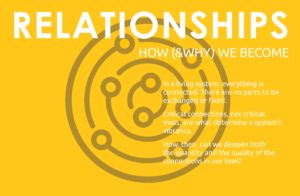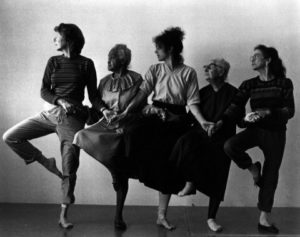The following is an excerpt from the forthcoming book, Living School: Learning from Nature How to Build a Better World, by Design.
Everything you see has its roots
In the unseen world . . .
Why do you weep?
That Source is within you
And this whole world
Is springing up from it.
–Rumi
In the beginning, everything was connected.
Along the way, some of us changed our minds.
And now, in the shadow of the Earth’s sixth mass extinction, our survival depends on our ability to rediscover the wisdom we have lost.
In the end, it turns out, everything is connected, and at every scale — from the cosmologic to the subatomic.
“Exalted we are,” writes the American biologist E.O. Wilson, “risen to be the mind of the biosphere without a doubt, our spirits uniquely capable of awe and ever more breathtaking leaps of imagination. But we are still part of Earth’s fauna and flora, bound to it by emotion, physiology, and, not least, deep history.”
“There are no individuals in a forest, no separable events,” says novelist Richard Powers. “The bird and the branch it sits on are a joint thing. Forests mend and shape themselves into subterranean synapses. And in shaping themselves, they shape, too, the tens of thousands of other, linked creatures that form it from within.”
This sort of deep relational weaving is central to indigenous cultures the world over. As American activist Winona LaDuke points out, “teachings, ancient as the people who have lived on a land for five millennia, speak of a set of relationships to all that is around, predicated on respect, recognition of the interdependency of all beings, an understanding of humans’ absolute need to be reverent and to manage our behavior, and an understanding that this relationship must be affirmed through lifeways and through acknowledgment of the sacred.”
Several hundred years ago, however, a new story began to emerge in Europe — one that was fueled by the discoveries of Copernicus, Kepler, and Galileo, and that would come to shape the later thinking of Descartes, Bacon, and Newton. It was a story that displaced us from the universal center, and urged us to no longer view nature as something to which we were bound, but something to be, in Bacon’s words, “hounded in her wanderings, and bound into service, and made a slave.”
When, in the 17th century, Decartes proclaimed Cogito ergo sum (“I think, therefore I exist”), and Newton developed a mathematical formulation that could provide a consistent mathematical theory of the world (i.e., classical physics), the narrative shift that had begun centuries earlier had finally been completed — away from the notion of an organic, living and spiritual universe, and toward a mechanistic, linear world of separable parts.
It’s the story that has dominated Western culture ever since.
Recently, however, its foundations have begun to crumble. New discoveries in the fields of quantum mechanics and electromagnetism have necessitated profound changes in concepts of everything from space to time to cause and effect. As Einstein put it: “All my attempts to adapt the theoretical foundations of physics to this [new type of knowledge have] failed completely. It was as if the ground had been pulled out from under one, with no firm foundation to be seen anywhere, upon which one could have built.”
In fact, the natural relationship between parts and wholes confirms what some have been saying all along — that the universe is not a clock; it’s a cloud. “As individuals and societies,” explains Austrian scientist and systems theorist Fritjof Capra, “we are all embedded in (and ultimately dependent on) the cyclical processes of nature. Nature sustains life by creating and nurturing communities.”
In fact, we are not just embedded in nature, but also to one another. “When you form groups,” writes Iain Couzin, who leads the Centre for the Advanced Study of Collective Behavior at the University of Konstanz, “you suddenly have a network system where social interactions exist. We have traditionally assumed that intelligence resides in our brains, in the individual animal. But we have found the first evidence that intelligence can also be encoded in the hidden network of communication between us.”
This is the profound lesson we need to learn from nature — a lesson that is equally true at the smallest scale.
“In the quantum world,” explains Margaret Wheatley, “relationship is the key determiner of everything.” Subatomic particles come into form and are observed only as they are in relationship to something else. They do not exist as independent entities. These unseen connections between what were previously thought to be separate entities are the fundamental ingredient of all creation.
“In this world, the basic building blocks of life are relationships, not individuals. Nothing exists on its own or has a final, fixed identity. We are all bundles of potential. Relationships evoke these potentials. We change as we meet different people or are in different circumstances.”
This is why the path towards creating a living school requires cultivating the individual and collective self-awareness that comes from understanding identity — who (& why) we are; applying information — what (& why) we notice; and strengthening relationships — how (& why) we connect. “Although each of these three domains has its own dynamism and motion,” explains educator Stephanie Pace-Marshall, “it is their confluence and synergy that create the generative landscape essential for individual and system wholeness, meaning, and connections. Relationships represent the dynamic, self-generating learning network of our systems, and they establish its capacity for collaborative inquiry.”
But what does that really mean in the work we do with one another in our communities, our organizations, and our schools?
How can we attend more intentionally, and see more clearly, the webwork of ways in which we are all interwoven?
As you’ll see in the stories and examples that follow, a higher level of relational attunement is not just what allows us to build healthier cultures; it’s what allows us to comprehend the full weight of our spiritual role in the cosmos — to be, as Wilson put it, the mind of the biosphere itself.
“A human being is part of the whole called by us ‘the universe,’” said Einstein, “a part limited in time and space. We experience ourselves, our thoughts and our feelings, as something separate from the rest — a kind of optical illusion of our consciousness. This delusion is a kind of prison for us, restricting us to our personal desires and affection for a few persons nearest to us. Our task must be to free ourselves from this prison by widening our circle of understanding and compassion to embrace all living creatures and the whole of Nature in its beauty.”
This is, in part, the gift of the art of Liz Lerman, who helps us see what a truly trans-disciplinary, trans-generational, trans-media approach to storytelling can reveal about who we are and how we connect.
It’s what we learn from the science of honeybees, whose deeply democratic, highly-effective form of life-or-death group decision-making helps demonstrate what a high-functioning collective intelligence can actually engender.
It’s what the work of UCLA psychology professor Dan Siegel makes visible, by providing us with a scientific definition of that most elusive of all human features — the mind — and helping us understand precisely what connects us both internally and externally.
And it’s what we can see and feel throughout the halls of Crosstown High, a public high school in Memphis, Tennessee that has crafted a student body, and a school campus, that are meant to tap the collective wisdom and shared culture of an entire city.
“Mutuality is the principle of the individual body as well as the law governing the interplay of all bodies. It is the key to understanding reality,” explains biologist Andreas Weber. “To understand ourselves, we have to recognize ourselves in other living creatures. To be mirrored is a central element in the formation of human identity.”
Virginia Woolf put it another way. “Behind the cotton wool is hidden a pattern. The whole world is a work of art . . . Hamlet or a Beethoven quartet is the truth about this vast mass that we call the world. But there is no Shakespeare, there is no Beethoven; certainly and emphatically there is no God.
“We are the words; we are the music; we are the thing itself.”


Recent Comments